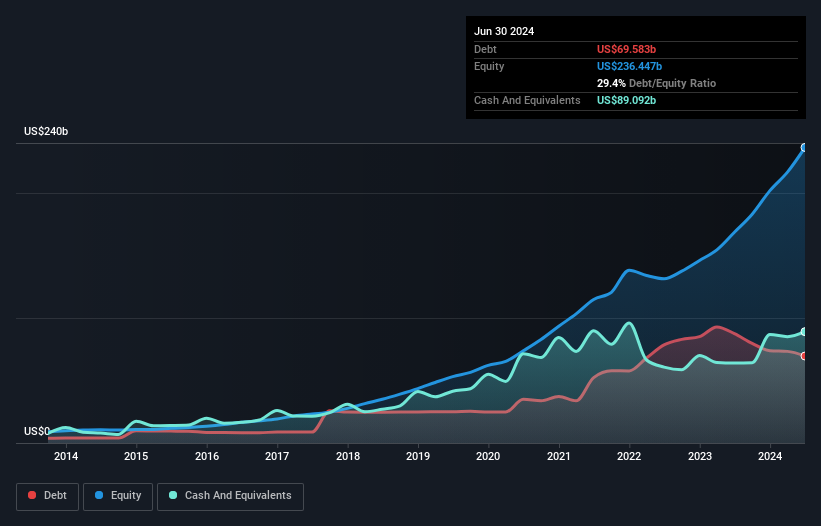- United States
- /
- General Merchandise and Department Stores
- /
- NasdaqGS:AMZN
Does Amazon.com (NASDAQ:AMZN) Have A Healthy Balance Sheet?
The external fund manager backed by Berkshire Hathaway's Charlie Munger, Li Lu, makes no bones about it when he says 'The biggest investment risk is not the volatility of prices, but whether you will suffer a permanent loss of capital.' So it might be obvious that you need to consider debt, when you think about how risky any given stock is, because too much debt can sink a company. We note that Amazon.com, Inc. (NASDAQ:AMZN) does have debt on its balance sheet. But the real question is whether this debt is making the company risky.
When Is Debt Dangerous?
Debt is a tool to help businesses grow, but if a business is incapable of paying off its lenders, then it exists at their mercy. If things get really bad, the lenders can take control of the business. However, a more usual (but still expensive) situation is where a company must dilute shareholders at a cheap share price simply to get debt under control. Of course, debt can be an important tool in businesses, particularly capital heavy businesses. The first thing to do when considering how much debt a business uses is to look at its cash and debt together.
See our latest analysis for Amazon.com
How Much Debt Does Amazon.com Carry?
You can click the graphic below for the historical numbers, but it shows that Amazon.com had US$69.6b of debt in June 2024, down from US$87.5b, one year before. But on the other hand it also has US$89.1b in cash, leading to a US$19.5b net cash position.

How Healthy Is Amazon.com's Balance Sheet?
According to the last reported balance sheet, Amazon.com had liabilities of US$158.2b due within 12 months, and liabilities of US$160.2b due beyond 12 months. Offsetting this, it had US$89.1b in cash and US$43.7b in receivables that were due within 12 months. So its liabilities total US$185.6b more than the combination of its cash and short-term receivables.
Given Amazon.com has a humongous market capitalization of US$1.84t, it's hard to believe these liabilities pose much threat. Having said that, it's clear that we should continue to monitor its balance sheet, lest it change for the worse. Despite its noteworthy liabilities, Amazon.com boasts net cash, so it's fair to say it does not have a heavy debt load!
Even more impressive was the fact that Amazon.com grew its EBIT by 193% over twelve months. If maintained that growth will make the debt even more manageable in the years ahead. The balance sheet is clearly the area to focus on when you are analysing debt. But it is future earnings, more than anything, that will determine Amazon.com's ability to maintain a healthy balance sheet going forward. So if you want to see what the professionals think, you might find this free report on analyst profit forecasts to be interesting.
But our final consideration is also important, because a company cannot pay debt with paper profits; it needs cold hard cash. Amazon.com may have net cash on the balance sheet, but it is still interesting to look at how well the business converts its earnings before interest and tax (EBIT) to free cash flow, because that will influence both its need for, and its capacity to manage debt. Looking at the most recent three years, Amazon.com recorded free cash flow of 25% of its EBIT, which is weaker than we'd expect. That's not great, when it comes to paying down debt.
Summing Up
While Amazon.com does have more liabilities than liquid assets, it also has net cash of US$19.5b. And it impressed us with its EBIT growth of 193% over the last year. So we don't think Amazon.com's use of debt is risky. Over time, share prices tend to follow earnings per share, so if you're interested in Amazon.com, you may well want to click here to check an interactive graph of its earnings per share history.
Of course, if you're the type of investor who prefers buying stocks without the burden of debt, then don't hesitate to discover our exclusive list of net cash growth stocks, today.
New: Manage All Your Stock Portfolios in One Place
We've created the ultimate portfolio companion for stock investors, and it's free.
• Connect an unlimited number of Portfolios and see your total in one currency
• Be alerted to new Warning Signs or Risks via email or mobile
• Track the Fair Value of your stocks
Have feedback on this article? Concerned about the content? Get in touch with us directly. Alternatively, email editorial-team (at) simplywallst.com.
This article by Simply Wall St is general in nature. We provide commentary based on historical data and analyst forecasts only using an unbiased methodology and our articles are not intended to be financial advice. It does not constitute a recommendation to buy or sell any stock, and does not take account of your objectives, or your financial situation. We aim to bring you long-term focused analysis driven by fundamental data. Note that our analysis may not factor in the latest price-sensitive company announcements or qualitative material. Simply Wall St has no position in any stocks mentioned.
About NasdaqGS:AMZN
Amazon.com
Engages in the retail sale of consumer products, advertising, and subscriptions service through online and physical stores in North America and internationally.
Flawless balance sheet with solid track record.
Similar Companies
Market Insights
Community Narratives



